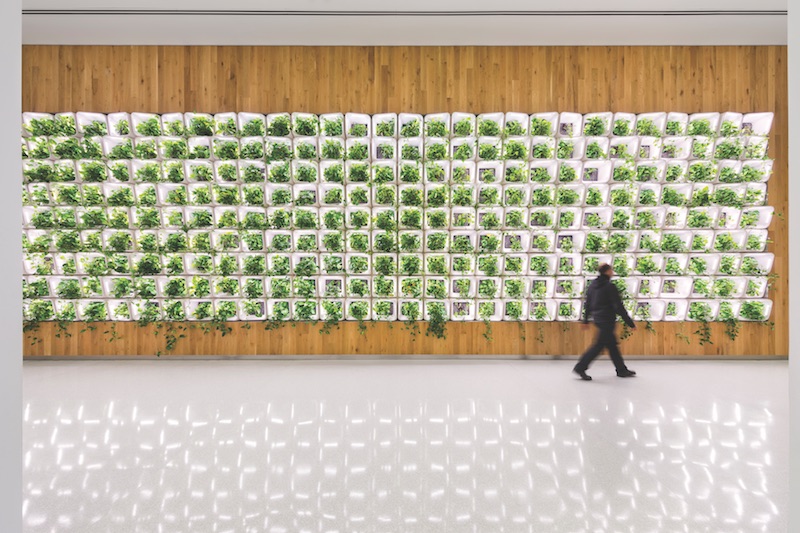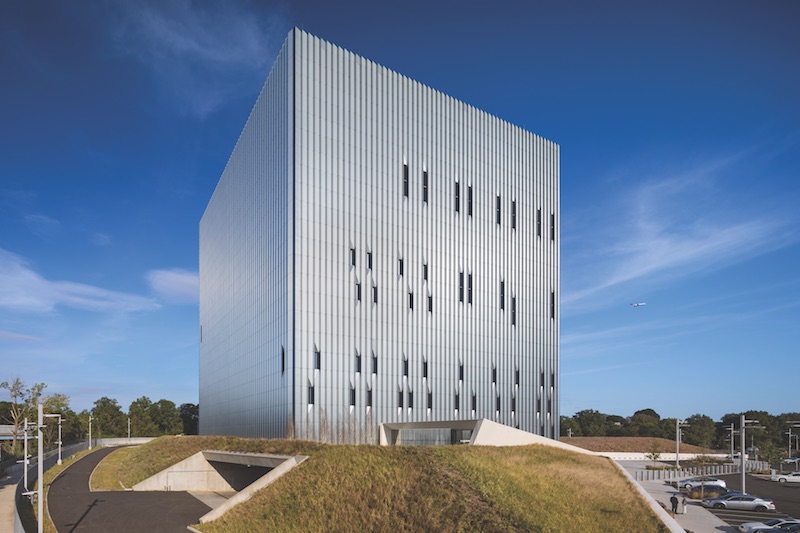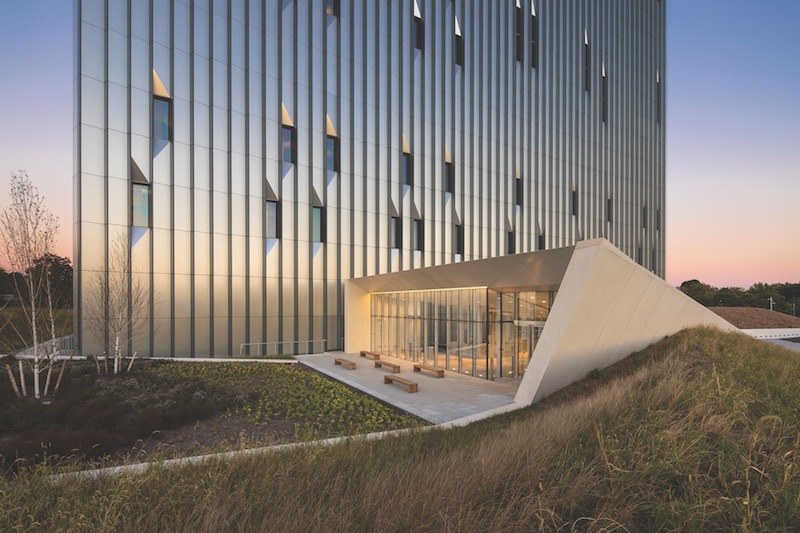With security and sustainability becoming critical factors in nonresidential construction, design sometimes takes a back seat on projects.
Case in point: New York City's second Public Safety Answering Center, known as PSAC II, which opened last June in the Bronx. The 450,000-sf facility, sitting on 8.75 acres along the Hutchinson River and Pelham Parkways, supplements PSAC I, located at the MetroTech Center in Brooklyn. The newer facility is set up to handle more than 11 million emergency 911 calls annually to the city’s police and fire departments.
As tall as a 24-story building, the cube-like PSAC II is a fortress protected by 15-inch-thick concrete walls, with a relatively limited number of windows for an edifice this size: 77 4x10-foot openings and 54 4x20-foot openings. There’s only one window on the west side of the facility, facing a train station. The main building’s overall window-to-wall ratio is 4%.
The windows and doors are blast- and tamper-proof. Computers, machinery, and mechanicals (often duplicated for security purposes) take up half the building’s floor space. Its 230 or so operators and dispatchers aren’t allowed to leave the building at any time during their work shifts, which sometimes last up to 14 hours.
“It was a challenge to take a vertical bunker and make it architecturally interesting, and a place where people working in a high-intensity environment could tolerate being inside of it,” recalls Gary Haney, FAIA, RIBA, Design Partner with Skidmore, Owings & Merrill. SOM, which also designed PSAC I, provided architectural services on the $800 million PSAC II. Jaros Baum & Bolles was the MEP Engineer, and Vidaris the sustainability consultant.
To make PSAC II something more than just a secure concrete box, SOM created what Haney describes as a “kind of camouflage” on the exterior with a sawtooth, two-color aluminum façade that has a “picket fence quality” and reflects sunlight.
 The plant wall is by CASE and Rensselaer Polytechnic Institute. Courtesy SOM/©Albert Vecerka|Esto.
The plant wall is by CASE and Rensselaer Polytechnic Institute. Courtesy SOM/©Albert Vecerka|Esto.
Working with landscape architect Thomas Balsley, FASLA, SOM further softened the building’s monolithic exterior by installing a wrap-around sculptural berm of wild grasses. Haney has described the berm as making the building appear to float. The berm also serves as security cover to help hide the facility, which has two floors underground and an attached entry pavilion. “When you view the berm from the inside, it creates an infinite landscape,” says Haney.
SOM laid out the building’s windows in an irregular pattern to give it design character. The firm paid particular attention to bringing natural light into the 50,000-sf, L-shaped call center, which has 30-foot-tall ceilings.
“We’ve gone back to the building almost every week since it opened, and what I’m most happy about is the amount of light that comes into the call center,” says Haney. “It’s a pleasant surprise.”
The same is true on the third floor, which is mostly office space. “From the inside, you hardly notice there aren’t a lot of windows,” he adds.
In order to fine-tune the mechanical systems, the project team took almost a year to commission the building. “That made a huge difference in controlling energy consumption,” says Haney. The effort helped PSAC II achieve LEED Gold certification.
The building earned LEED points for its use of a living wall in its lobby and cafeteria areas. The plant wall—developed by CASE, SOM’s design research laboratory, in partnership with Rensselaer Polytechnic Institute—acts as a natural air filter and a center of engagement for the building’s occupants.
“It became part of the idea of making the indoors more livable,” says Haney, who adds that the city was very receptive to including this design feature.
 Landscape architect Thomas Balsley Associates created the grass berm. Courtesy SOM/©Albert Vecerka|Esto.
Landscape architect Thomas Balsley Associates created the grass berm. Courtesy SOM/©Albert Vecerka|Esto.
Related Stories
Sustainability | Mar 21, 2024
World’s first TRUE-certified building project completed in California
GENESIS Marina, an expansive laboratory and office campus in Brisbane, Calif., is the world’s first Total Resource Use and Efficiency (TRUE)-certified construction endeavor. The certification recognizes projects that achieve outstanding levels of resource efficiency through waste reduction, reuse, and recycling practices.
Codes and Standards | Mar 18, 2024
New urban stormwater policies treat rainwater as a resource
U.S. cities are revamping how they handle stormwater to reduce flooding and capture rainfall and recharge aquifers. New policies reflect a change in mindset from treating stormwater as a nuisance to be quickly diverted away to capturing it as a resource.
Sustainability | Mar 13, 2024
Trends to watch shaping the future of ESG
Gensler’s Climate Action & Sustainability Services Leaders Anthony Brower, Juliette Morgan, and Kirsten Ritchie discuss trends shaping the future of environmental, social, and governance (ESG).
Sustainability | Feb 26, 2024
GBBN's Inflation Reduction Act Calculator goes live
GBBN has publicly released its IRA Calculator, a tool that helps you understand funding opportunities in the IRA for sustainable design.
MFPRO+ News | Feb 15, 2024
Nine states pledge to transition to heat pumps for residential HVAC and water heating
Nine states have signed a joint agreement to accelerate the transition to residential building electrification by significantly expanding heat pump sales to meet heating, cooling, and water heating demand. The Memorandum of Understanding was signed by directors of environmental agencies from California, Colorado, Maine, Maryland, Massachusetts, New Jersey, New York, Oregon, and Rhode Island.
Green | Feb 15, 2024
FEMA issues guidance on funding for net zero buildings
The Federal Emergency Management Agency (FEMA) recently unveiled new guidance on additional assistance funding for net zero buildings. The funding is available for implementing net-zero energy projects with a tie to disaster recovery or mitigation.
Sustainability | Feb 7, 2024
9 states pledge to accelerate transition to clean residential buildings
States from coast to coast have signed a joint agreement to accelerate the transition to pollution-free residential buildings by significantly expanding heat pump sales to meet heating, cooling, and water heating demand in coming years.
Industry Research | Jan 31, 2024
ASID identifies 11 design trends coming in 2024
The Trends Outlook Report by the American Society of Interior Designers (ASID) is the first of a three-part outlook series on interior design. This design trends report demonstrates the importance of connection and authenticity.
Concrete | Jan 12, 2024
Sustainable concrete reduces carbon emissions by at least 30%
Designed by Holcim, a building materials supplier, ECOPact offers a sustainable concrete alternative that not only meets, but exceeds the properties of standard concrete.
Sustainability | Jan 10, 2024
New passive house partnership allows lower cost financing for developers
The new partnership between PACE Equity and Phius allows commercial passive house projects to be automatically eligible for CIRRUS Low Carbon financing.

















